Fig 1. Transgenic expression of CSEP0064/BEC1054 in plants enhances susceptibility to adapted pathogens.
A) The presence of the transgene wbec1054, encoding CSEP0064/BEC1054 from the non-adapted barley powdery mildew pathogen, increases haustorium formation of the adapted pathogen B. graminis f.sp. tritici in wheat. Two centimeter leaf segments were taken from primary leaves (young plants), or from the third most recent leaf (mature plants), and the mean proportion of germinated conidia that produced a functional haustorium (determined by measuring the number of colonies forming an extensive network of epiphytic hyphae) was assessed. Plants were either homozygous (+/+) or azygous (-/-) siblings for wbec1054. Young plants were three weeks old, and mature plants were eleven weeks old. The boxes represent the quartiles, the thick line denotes the median, and maximum and minimum values are shown by the error bars. B) Sporangia production by the adapted downy mildew pathogen P. tabacina is increased in N. benthamiana by expression of CSEP0064/BEC1054 from the non-adapted barley powdery mildew pathogen. N. benthamiana leaves were infiltrated on one side of the midrib with Agrobacteria delivering plasmids encoding GFP and RFP, and on the other side with Agrobacteria delivering plasmids encoding CSEP0064/BEC1054 with a C-terminal GFP tag and RFP (as a transformation marker). Leaves were inoculated, within one hour of infiltration, with P. tabacina sporangia on their abaxial surface. After ten days, leaf disks were collected from each leaf, the sporangia removed via washing, counted, and used to calculate the mean. Significantly more sporangia were found with CSEP0064/BEC1054-GFP than with GFP only (n = 5, p<0.001). The thick line denotes the median of each boxplot, the boxes represent the quartiles, maximum and minimum values are shown by the error bars.

